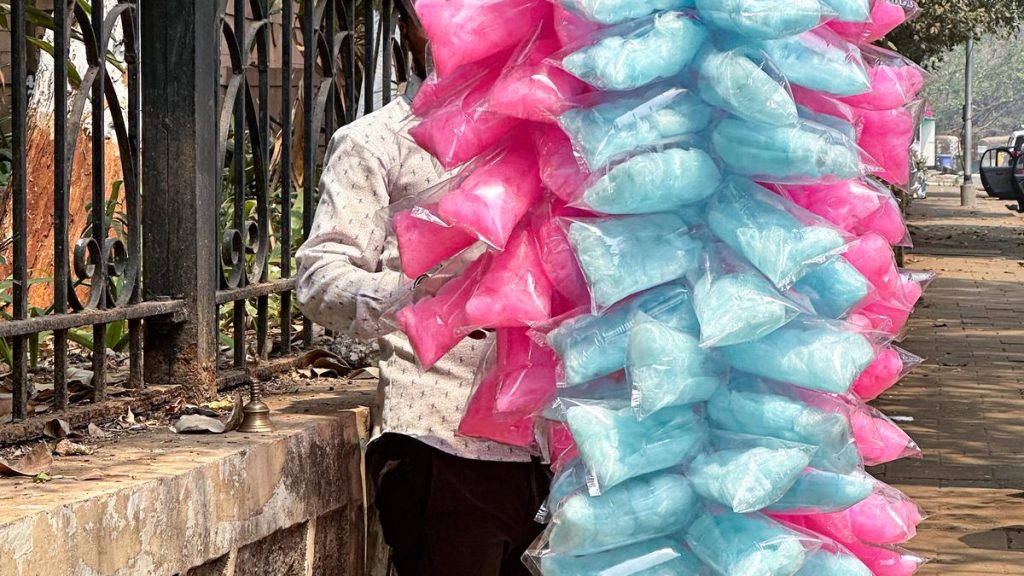Context:
Recently, the Karnataka government banned the use of artificial food colouring agents in gobhi manchurian and cotton candy due to health concerns.
More on the news
- Artificial colourings like Rhodamine B, Sunset Yellow, Tartrazine, and Carmoisine were found in 107 of the 171 gobhi manchurian samples and 15 of the 25 cotton candy samples tested by the State government.
- Based on these findings, an order was issued by the Commissioner of Food Safety to ban the use of prohibited artificial colours, including Rhodamine B.
- Violation of this ban will lead to imprisonment of up to 7 years and a fine of up to Rs 10 lakhs.
- The consumption of foods/snacks containing these artificial colours poses long-term health risks, including cancer.
- Small vendors in small cities in India usually add Rhodamine B illegally to food products like gobhi manchurian, potato wedges, butter chicken, pomegranate juice, ice creams, and cotton candies.
- However, it is not commonly seen in bigger cities like Delhi and Mumbai where edible food colours are used to give the red colour.
FSSAI Approved Colours
- The Food Safety and Standards Authority of India (FSSAI) allows very few natural and synthetic colours to be used in food items.
- Allowed Natural colours include carotene and carotenoids (yellow, orange), chlorophyll (green), riboflavin (yellow), caramel, Annatto (orange-red, derived from the seed of an American tree), saffron, and curcumin (yellow, from turmeric).
Allowed Synthetic colours include
- Ponceau 4R, Carmoisine, Erythrosine for Red
- Tartrazine, Sunset Yellow FCF for Yellow
- Indigo Carmine, Brilliant Blue FCF for Blue
- Fast Green FCF for Green
- However, the permissible food colours are restricted in their use in food items like ice creams, biscuits, cakes, confectionaries, fruit syrups and crushes, carbonated or noncarbonated beverages, etc.
About FSSAI
- It is an autonomous statutory body established under the Food Safety and Standards Act, 2006.
- Established in 2008, it functions under the administration of the Ministry of Health and Family Welfare, Government of India.
- Headquartered in New Delhi.
- The FSSAI comprises of a Chairperson and twenty-two members out of which one-third are to be women.
- It has been created for laying down science-based standards for articles of food and to regulate their manufacture, storage, distribution, sale and import to ensure availability of safe and wholesome food for human consumption.
Rhodamine B
- Chemical Formula: C28H31ClN2O3
- Appearance: Red to violet powder and gives red and pink colours.
It is a chemical colour used in dyeing clothes, paper, leather, printing, and plastics.
- It is highly soluble in water, making it a versatile dye.
- It’s not fit for consumption and may cause acute toxicity, eye damage, and respiratory irritation.
- It’s not classified as carcinogenic to humans, but some studies on rats showed carcinogenic effects.
- Long-term effects are unclear, but potential risks include organ damage and developmental problems. Severity depends on the amount consumed and individual factors.

Applications:
- Dyes: Used in various applications like colouring paper, textiles (including cotton, wool, silk, polyester, and nylon), and plastics.
Fluorescent Tracer: Widely used in scientific research as a tracer dye due to its fluorescence. This allows scientists to track the movement of fluids or identify specific parts of a sample. Examples include:
- Water Flow Studies: Monitoring water flow in rivers, streams, and irrigation systems.
- Biological Assays: Studying cellular processes and interactions where visualization of specific molecules is needed.
- Leak Detection: Identifying leaks in pipes or other containment systems.
- Cosmetics: Limited use in some cosmetic products due to potential safety concerns.
- Microscopy: Can be used as a staining agent in microscopy techniques.

